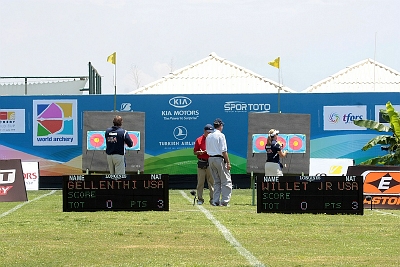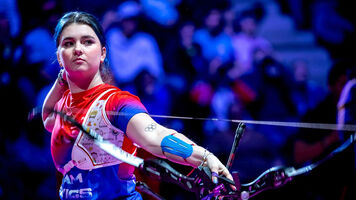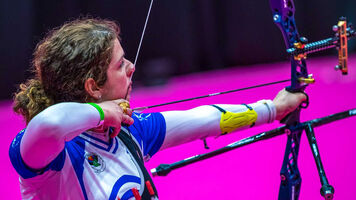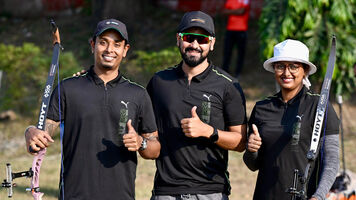This content is archived and as has not been processed. It may contain unformatted text or images, broken links or out-of-date information.
Archive
29 July 2010 - Hit or Miss—analysing the first results of the new World Archery compound round
Lausanne
Hit or Miss—analysing the first results of the new World Archery compound round
Lausanne – 29 July 2010
In 2009, World Archery (FITA) implemented many changes that, so far this season, have had a substantial impact on the conduct of, and outcomes of, World Archery events such as the World Cup circuit. Recently we discussed the impact of the changes on archery individual matches with the new Set System format used for the first time at the World Cup in Porec (CRO). This time we will focus on the Compound Round that was introduced at the last World Cup stage in Antalya (TUR).
 Let’s see what the new round has shown so far, and also give an update on some changes already made to the original version of the round. To note, the World Cup Stage 3 in Odgen (USA), will feature the Set System format used in Porec for recurve matches, while the compound athletes will play upon the updated rules of the Compound Round.
There is no question that the new 50m compound round has had a significant impact on the participating shooters. In some cases, upsets have been produced, and some very top level archers have even been found missing the entire target as the new look and new pressure of the round has triggered a variety of performance issues in some shooters. Meanwhile, others have risen to the occasion to take the podium—in some cases, for the first time ever.
The main difference between previous rounds and the new rounds is implementation of the set system- basically, sets of 3 (or, in the newly revised compound team round, 6) arrows decide a winner or loser for that specific set. The match is decided by the winning of a number of these sets. For compounds, these changes have been supplemented by a critical additional change—a new, 50m hit/Miss target with a 10cm hit zone. This new target has proven very challenging for the world’s top shooters—much more so than expected.
Before we discuss the impact of the new target, let’s recap the new format for compounds.
Qualification round—50m on a special, new "6-ring" (10 through 5 ring) target face, shot for score.
All individual matches through semifinals are shot on the new "Hit/Miss" face, consisting of a 10cm "hit" zone printed in yellow on a red background surrounded by a blue background. Only arrows in the yellow zone count. Anything else scores as a miss.
Ø 4 sets of 3 arrows
Ø 2 minutes to shoot 3 arrows
Ø Winner has the most set points (2 points per set won, 1 point per set tied)
Note however, that medal matches are different:
Ø 6 sets of 3 arrows
Ø Alternate shooting, 20 seconds per arrow
Ø Winner has the most set points after the 6 sets (7 points needed to win)
Updates on the Compound Round for Ogden
After the Antalya event, which used the qualification ranking to decide any ties, FITA Council made a change to the rules. Going forward, in case of a tie, a shoot-off will be conducted to decide the winner.
FITA Council also recently made an important change to the team round, after the experience of the first world cup event with the new round in Antalya, Turkey this season.
Rather than a team round consisting of 4 sets of 3 arrows in preliminaries, all sets will now consist of 2 arrows per team member—6 arrows. The finals will feature 36 arrows, 6 sets of 6 arrows in two minutes (20 sec per arrow). Alternate shooting means some teams will be hard-pressed for time if they don’t train for this round.
What is going on with the new target?
Surprisingly, some of the top shooters have had considerable difficulty with the new target. In some cases obvious "target panic" has been exhibited by top level shooters, with arrows entirely missing the paper, and it has not been uncommon to see shots missing the hit zone by margins that would produce a 5 or 6 point score on a standard 80cm face from shooters ordinarily shooting scores well into the mid and high 350’s on the standard 50m target. So what is going on?
It seems there are two specific issues at work—one technical and the other psychological.
Technical issues with the hit/miss target
A consensus is developing indicating that in some cases, apertures and scope magnifications suitable for the standard 70m round and even the 50m round may be unsuitable for the 50m Hit/Miss target. In the case of some top shooters, the lack of scoring rings is causing issues.
In other cases the reticles used on their scopes—in particular, solid dots—are proving too large for the 9cm hit zone, making it difficult to aim.
In many cases of this type, archers had only minimally prepared for the new round and were caught unprepared, especially once the pressure of an actual round was applied.
Also, the most successful shooters on the new round have proven to be those who have stayed with their high-performance small diameter shafts normally used for 70m competition.
It turns out that the attempts to use "fat shafts" in the new round have not been successful, with shooters failing to advance past the very first rounds in every single case.
The solution to the technical issues considered on their own are relatively simple—no changes to equipment except for scope magnification and reticle configuration and/or size, and adequate practice with the new target in different lighting conditions.
Psychological factors
There is no question that some very accomplished shooters had serious execution and timing issues with the new target. In some cases, these were evidenced as a complete breakdown of form and timing—outright "target panic" in which the shooter was either involuntarily "punching" the shot, or holding for an extraordinarily long time, trying to execute the shot while fighting the subconscious. In nearly every case, the root cause was a shift in the attitude of the shooter toward the target—which can be characterised as a subtle shift in attitude from a positive—"I will hit the target"—to a negative—"I don’t want to miss!" Most top compound shooters can overcome this with additional training and experience with the new round, but it is quite noteworthy that this was happening to even the most experienced shooters, once the pressure of the new round combined with the unique aspect of the set system to force a whole new set of circumstances onto the field of play.
Conclusion
Certainly the past has demonstrated that there are some top shooters who are highly adaptable to change, and these shooters will prosper under the new round. The past has also demonstrated that some top shooters cannot manage the adjustments needed for the new rounds, and some of these will fall by the wayside to be replaced by new, up and coming competitors whose ability and psychology works well for the new round. One thing is clear—more shooters need more opportunities to shoot the new round in order to learn how to be successful with it. This means that all World Archery member organisations should take all available steps to make the new round as available to their membership as possible. Competitiveness in the round hangs in the balance.
George TEKMITCHOV
World Archery Commentator
Let’s see what the new round has shown so far, and also give an update on some changes already made to the original version of the round. To note, the World Cup Stage 3 in Odgen (USA), will feature the Set System format used in Porec for recurve matches, while the compound athletes will play upon the updated rules of the Compound Round.
There is no question that the new 50m compound round has had a significant impact on the participating shooters. In some cases, upsets have been produced, and some very top level archers have even been found missing the entire target as the new look and new pressure of the round has triggered a variety of performance issues in some shooters. Meanwhile, others have risen to the occasion to take the podium—in some cases, for the first time ever.
The main difference between previous rounds and the new rounds is implementation of the set system- basically, sets of 3 (or, in the newly revised compound team round, 6) arrows decide a winner or loser for that specific set. The match is decided by the winning of a number of these sets. For compounds, these changes have been supplemented by a critical additional change—a new, 50m hit/Miss target with a 10cm hit zone. This new target has proven very challenging for the world’s top shooters—much more so than expected.
Before we discuss the impact of the new target, let’s recap the new format for compounds.
Qualification round—50m on a special, new "6-ring" (10 through 5 ring) target face, shot for score.
All individual matches through semifinals are shot on the new "Hit/Miss" face, consisting of a 10cm "hit" zone printed in yellow on a red background surrounded by a blue background. Only arrows in the yellow zone count. Anything else scores as a miss.
Ø 4 sets of 3 arrows
Ø 2 minutes to shoot 3 arrows
Ø Winner has the most set points (2 points per set won, 1 point per set tied)
Note however, that medal matches are different:
Ø 6 sets of 3 arrows
Ø Alternate shooting, 20 seconds per arrow
Ø Winner has the most set points after the 6 sets (7 points needed to win)
Updates on the Compound Round for Ogden
After the Antalya event, which used the qualification ranking to decide any ties, FITA Council made a change to the rules. Going forward, in case of a tie, a shoot-off will be conducted to decide the winner.
FITA Council also recently made an important change to the team round, after the experience of the first world cup event with the new round in Antalya, Turkey this season.
Rather than a team round consisting of 4 sets of 3 arrows in preliminaries, all sets will now consist of 2 arrows per team member—6 arrows. The finals will feature 36 arrows, 6 sets of 6 arrows in two minutes (20 sec per arrow). Alternate shooting means some teams will be hard-pressed for time if they don’t train for this round.
What is going on with the new target?
Surprisingly, some of the top shooters have had considerable difficulty with the new target. In some cases obvious "target panic" has been exhibited by top level shooters, with arrows entirely missing the paper, and it has not been uncommon to see shots missing the hit zone by margins that would produce a 5 or 6 point score on a standard 80cm face from shooters ordinarily shooting scores well into the mid and high 350’s on the standard 50m target. So what is going on?
It seems there are two specific issues at work—one technical and the other psychological.
Technical issues with the hit/miss target
A consensus is developing indicating that in some cases, apertures and scope magnifications suitable for the standard 70m round and even the 50m round may be unsuitable for the 50m Hit/Miss target. In the case of some top shooters, the lack of scoring rings is causing issues.
In other cases the reticles used on their scopes—in particular, solid dots—are proving too large for the 9cm hit zone, making it difficult to aim.
In many cases of this type, archers had only minimally prepared for the new round and were caught unprepared, especially once the pressure of an actual round was applied.
Also, the most successful shooters on the new round have proven to be those who have stayed with their high-performance small diameter shafts normally used for 70m competition.
It turns out that the attempts to use "fat shafts" in the new round have not been successful, with shooters failing to advance past the very first rounds in every single case.
The solution to the technical issues considered on their own are relatively simple—no changes to equipment except for scope magnification and reticle configuration and/or size, and adequate practice with the new target in different lighting conditions.
Psychological factors
There is no question that some very accomplished shooters had serious execution and timing issues with the new target. In some cases, these were evidenced as a complete breakdown of form and timing—outright "target panic" in which the shooter was either involuntarily "punching" the shot, or holding for an extraordinarily long time, trying to execute the shot while fighting the subconscious. In nearly every case, the root cause was a shift in the attitude of the shooter toward the target—which can be characterised as a subtle shift in attitude from a positive—"I will hit the target"—to a negative—"I don’t want to miss!" Most top compound shooters can overcome this with additional training and experience with the new round, but it is quite noteworthy that this was happening to even the most experienced shooters, once the pressure of the new round combined with the unique aspect of the set system to force a whole new set of circumstances onto the field of play.
Conclusion
Certainly the past has demonstrated that there are some top shooters who are highly adaptable to change, and these shooters will prosper under the new round. The past has also demonstrated that some top shooters cannot manage the adjustments needed for the new rounds, and some of these will fall by the wayside to be replaced by new, up and coming competitors whose ability and psychology works well for the new round. One thing is clear—more shooters need more opportunities to shoot the new round in order to learn how to be successful with it. This means that all World Archery member organisations should take all available steps to make the new round as available to their membership as possible. Competitiveness in the round hangs in the balance.
George TEKMITCHOV
World Archery Commentator
 Let’s see what the new round has shown so far, and also give an update on some changes already made to the original version of the round. To note, the World Cup Stage 3 in Odgen (USA), will feature the Set System format used in Porec for recurve matches, while the compound athletes will play upon the updated rules of the Compound Round.
There is no question that the new 50m compound round has had a significant impact on the participating shooters. In some cases, upsets have been produced, and some very top level archers have even been found missing the entire target as the new look and new pressure of the round has triggered a variety of performance issues in some shooters. Meanwhile, others have risen to the occasion to take the podium—in some cases, for the first time ever.
The main difference between previous rounds and the new rounds is implementation of the set system- basically, sets of 3 (or, in the newly revised compound team round, 6) arrows decide a winner or loser for that specific set. The match is decided by the winning of a number of these sets. For compounds, these changes have been supplemented by a critical additional change—a new, 50m hit/Miss target with a 10cm hit zone. This new target has proven very challenging for the world’s top shooters—much more so than expected.
Before we discuss the impact of the new target, let’s recap the new format for compounds.
Qualification round—50m on a special, new "6-ring" (10 through 5 ring) target face, shot for score.
All individual matches through semifinals are shot on the new "Hit/Miss" face, consisting of a 10cm "hit" zone printed in yellow on a red background surrounded by a blue background. Only arrows in the yellow zone count. Anything else scores as a miss.
Ø 4 sets of 3 arrows
Ø 2 minutes to shoot 3 arrows
Ø Winner has the most set points (2 points per set won, 1 point per set tied)
Note however, that medal matches are different:
Ø 6 sets of 3 arrows
Ø Alternate shooting, 20 seconds per arrow
Ø Winner has the most set points after the 6 sets (7 points needed to win)
Updates on the Compound Round for Ogden
After the Antalya event, which used the qualification ranking to decide any ties, FITA Council made a change to the rules. Going forward, in case of a tie, a shoot-off will be conducted to decide the winner.
FITA Council also recently made an important change to the team round, after the experience of the first world cup event with the new round in Antalya, Turkey this season.
Rather than a team round consisting of 4 sets of 3 arrows in preliminaries, all sets will now consist of 2 arrows per team member—6 arrows. The finals will feature 36 arrows, 6 sets of 6 arrows in two minutes (20 sec per arrow). Alternate shooting means some teams will be hard-pressed for time if they don’t train for this round.
What is going on with the new target?
Surprisingly, some of the top shooters have had considerable difficulty with the new target. In some cases obvious "target panic" has been exhibited by top level shooters, with arrows entirely missing the paper, and it has not been uncommon to see shots missing the hit zone by margins that would produce a 5 or 6 point score on a standard 80cm face from shooters ordinarily shooting scores well into the mid and high 350’s on the standard 50m target. So what is going on?
It seems there are two specific issues at work—one technical and the other psychological.
Technical issues with the hit/miss target
A consensus is developing indicating that in some cases, apertures and scope magnifications suitable for the standard 70m round and even the 50m round may be unsuitable for the 50m Hit/Miss target. In the case of some top shooters, the lack of scoring rings is causing issues.
In other cases the reticles used on their scopes—in particular, solid dots—are proving too large for the 9cm hit zone, making it difficult to aim.
In many cases of this type, archers had only minimally prepared for the new round and were caught unprepared, especially once the pressure of an actual round was applied.
Also, the most successful shooters on the new round have proven to be those who have stayed with their high-performance small diameter shafts normally used for 70m competition.
It turns out that the attempts to use "fat shafts" in the new round have not been successful, with shooters failing to advance past the very first rounds in every single case.
The solution to the technical issues considered on their own are relatively simple—no changes to equipment except for scope magnification and reticle configuration and/or size, and adequate practice with the new target in different lighting conditions.
Psychological factors
There is no question that some very accomplished shooters had serious execution and timing issues with the new target. In some cases, these were evidenced as a complete breakdown of form and timing—outright "target panic" in which the shooter was either involuntarily "punching" the shot, or holding for an extraordinarily long time, trying to execute the shot while fighting the subconscious. In nearly every case, the root cause was a shift in the attitude of the shooter toward the target—which can be characterised as a subtle shift in attitude from a positive—"I will hit the target"—to a negative—"I don’t want to miss!" Most top compound shooters can overcome this with additional training and experience with the new round, but it is quite noteworthy that this was happening to even the most experienced shooters, once the pressure of the new round combined with the unique aspect of the set system to force a whole new set of circumstances onto the field of play.
Conclusion
Certainly the past has demonstrated that there are some top shooters who are highly adaptable to change, and these shooters will prosper under the new round. The past has also demonstrated that some top shooters cannot manage the adjustments needed for the new rounds, and some of these will fall by the wayside to be replaced by new, up and coming competitors whose ability and psychology works well for the new round. One thing is clear—more shooters need more opportunities to shoot the new round in order to learn how to be successful with it. This means that all World Archery member organisations should take all available steps to make the new round as available to their membership as possible. Competitiveness in the round hangs in the balance.
George TEKMITCHOV
World Archery Commentator
Let’s see what the new round has shown so far, and also give an update on some changes already made to the original version of the round. To note, the World Cup Stage 3 in Odgen (USA), will feature the Set System format used in Porec for recurve matches, while the compound athletes will play upon the updated rules of the Compound Round.
There is no question that the new 50m compound round has had a significant impact on the participating shooters. In some cases, upsets have been produced, and some very top level archers have even been found missing the entire target as the new look and new pressure of the round has triggered a variety of performance issues in some shooters. Meanwhile, others have risen to the occasion to take the podium—in some cases, for the first time ever.
The main difference between previous rounds and the new rounds is implementation of the set system- basically, sets of 3 (or, in the newly revised compound team round, 6) arrows decide a winner or loser for that specific set. The match is decided by the winning of a number of these sets. For compounds, these changes have been supplemented by a critical additional change—a new, 50m hit/Miss target with a 10cm hit zone. This new target has proven very challenging for the world’s top shooters—much more so than expected.
Before we discuss the impact of the new target, let’s recap the new format for compounds.
Qualification round—50m on a special, new "6-ring" (10 through 5 ring) target face, shot for score.
All individual matches through semifinals are shot on the new "Hit/Miss" face, consisting of a 10cm "hit" zone printed in yellow on a red background surrounded by a blue background. Only arrows in the yellow zone count. Anything else scores as a miss.
Ø 4 sets of 3 arrows
Ø 2 minutes to shoot 3 arrows
Ø Winner has the most set points (2 points per set won, 1 point per set tied)
Note however, that medal matches are different:
Ø 6 sets of 3 arrows
Ø Alternate shooting, 20 seconds per arrow
Ø Winner has the most set points after the 6 sets (7 points needed to win)
Updates on the Compound Round for Ogden
After the Antalya event, which used the qualification ranking to decide any ties, FITA Council made a change to the rules. Going forward, in case of a tie, a shoot-off will be conducted to decide the winner.
FITA Council also recently made an important change to the team round, after the experience of the first world cup event with the new round in Antalya, Turkey this season.
Rather than a team round consisting of 4 sets of 3 arrows in preliminaries, all sets will now consist of 2 arrows per team member—6 arrows. The finals will feature 36 arrows, 6 sets of 6 arrows in two minutes (20 sec per arrow). Alternate shooting means some teams will be hard-pressed for time if they don’t train for this round.
What is going on with the new target?
Surprisingly, some of the top shooters have had considerable difficulty with the new target. In some cases obvious "target panic" has been exhibited by top level shooters, with arrows entirely missing the paper, and it has not been uncommon to see shots missing the hit zone by margins that would produce a 5 or 6 point score on a standard 80cm face from shooters ordinarily shooting scores well into the mid and high 350’s on the standard 50m target. So what is going on?
It seems there are two specific issues at work—one technical and the other psychological.
Technical issues with the hit/miss target
A consensus is developing indicating that in some cases, apertures and scope magnifications suitable for the standard 70m round and even the 50m round may be unsuitable for the 50m Hit/Miss target. In the case of some top shooters, the lack of scoring rings is causing issues.
In other cases the reticles used on their scopes—in particular, solid dots—are proving too large for the 9cm hit zone, making it difficult to aim.
In many cases of this type, archers had only minimally prepared for the new round and were caught unprepared, especially once the pressure of an actual round was applied.
Also, the most successful shooters on the new round have proven to be those who have stayed with their high-performance small diameter shafts normally used for 70m competition.
It turns out that the attempts to use "fat shafts" in the new round have not been successful, with shooters failing to advance past the very first rounds in every single case.
The solution to the technical issues considered on their own are relatively simple—no changes to equipment except for scope magnification and reticle configuration and/or size, and adequate practice with the new target in different lighting conditions.
Psychological factors
There is no question that some very accomplished shooters had serious execution and timing issues with the new target. In some cases, these were evidenced as a complete breakdown of form and timing—outright "target panic" in which the shooter was either involuntarily "punching" the shot, or holding for an extraordinarily long time, trying to execute the shot while fighting the subconscious. In nearly every case, the root cause was a shift in the attitude of the shooter toward the target—which can be characterised as a subtle shift in attitude from a positive—"I will hit the target"—to a negative—"I don’t want to miss!" Most top compound shooters can overcome this with additional training and experience with the new round, but it is quite noteworthy that this was happening to even the most experienced shooters, once the pressure of the new round combined with the unique aspect of the set system to force a whole new set of circumstances onto the field of play.
Conclusion
Certainly the past has demonstrated that there are some top shooters who are highly adaptable to change, and these shooters will prosper under the new round. The past has also demonstrated that some top shooters cannot manage the adjustments needed for the new rounds, and some of these will fall by the wayside to be replaced by new, up and coming competitors whose ability and psychology works well for the new round. One thing is clear—more shooters need more opportunities to shoot the new round in order to learn how to be successful with it. This means that all World Archery member organisations should take all available steps to make the new round as available to their membership as possible. Competitiveness in the round hangs in the balance.
George TEKMITCHOV
World Archery Commentator









